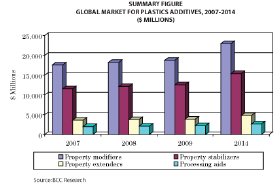Jul 15 2009
According to a new technical market research report, Plastics Additives: The Global Market (PLS022B) from BCC Research, the global market for plastics additives was worth more than $36.2 billion in 2008 and an estimated $37.4 billion in 2009. That is expected to increase to $45.8 billion in 2014, for a compound annual growth rate (CAGR) of 4.1%.

The market is broken down into property modifiers, property stabilizers, property extenders and processing aids. Of these, the property modifiers segment has the largest share of the market, worth $18.2 billion in 2008. That is expected to increase to $18.7 billion in 2009 and $22.9 billion in 2014, for a CAGR of 4.1%.
The second-largest segment is property stabilizers, which generated $12.1 billion in 2008 and an estimated $12.6 billion in 2009. This should increase to $15.4 billion in 2014, for a CAGR of 4.2%.
Property extenders have the third-largest market share, with revenues of $3.8 billion in 2008. This segment is expected to increase to $3.9 billion in 2009 and $4.8 billion in 2014, for a CAGR of 4.2%.
Additives are integral components in plastics and contribute to the success of plastics not only in processability but also in property modification and performance. Plastics would not have been able to deliver their performance without the addition of these polymer additives. Although used at only 5% to 7% in terms of weight, or about 10% by cost, they provide immense benefits and have contributed to the success of plastics.
Without additives, plastics would not work, but with them plastics can be made safer, cleaner, tougher, and more colorful. Additives cost money, but by reducing production costs and making products last longer, they help in saving money and conserving the world's precious raw material reserves.
The plastics additive industry turned the corner in 2007 after undergoing more than five strenuous years of structural market changes, including reduction in margins, rapid increases in feedstock prices, product-lifecycle maturity, transfer of growth to emerging markets, and regulatory pressures.